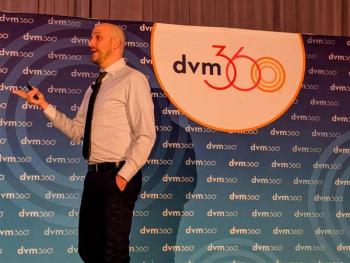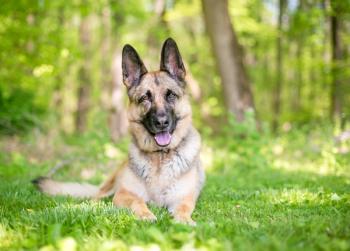
Gastric tumors--does ultrasonography help (Proceedings)
In dogs and cats, the most common ultrasonographic feature of gastric tumors is marked thickening of the wall with complete loss of wall layering.
In dogs and cats, the most common ultrasonographic feature of gastric tumors is marked thickening of the wall with complete loss of wall layering. During the presentation, the ultrasonographic features of the most common gastric tumors will be emphasized.
Gastric lymphoma appear as transmural thickening associated with complete loss of normal wall layering, reduced wall echogenicity, reduced motility and regional lymphadenopathy. These features are similar in dogs and cats. The thickening of the gastric wall can widely range from 5 mm to over 25 mm. Gastric masses may be partially masked by the presence of gas in the lumen, particularly when located on the lesser curvature. Regional lymphadenopathy is a common finding in lymphoma. Ulcerated lymphoma can be encountered as an irregular mucosal surface or a large defect centered on the affected portion of the stomach.
The most common ultrasonographic findings of gastric carcinoma are transmural thickening of the wall associated with altered wall layering. This altered layering appears as a moderately echogenic zone surrounded by outer and inner poorly-echogenic lines of variable thickness. This feature, when recognized, is present in many affected dogs. However, other associated mural changes such as edema, inflammation, fibrosis or hemorrhage could mask this hallmark feature. Because of this particular appearance of infiltrated layers, and to avoid confusion with the term “layered wall” reserved to describe the normal appearance of the GI wall, we called this feature “pseudo-layering”. This pseudo-layering most likely correlates with the unevenly layered tumor distribution noted histopathologically. This particular ultrasonographic feature, when present, is strongly suggestive of gastric carcinoma. Regional (gastric) lymphadenopathy is very commonly seen at the time of the ultrasonographic diagnosis. The enlarged lymph node is either poorly echogenic or has a target appearance. Other adjacent structures and organs should be carefully evaluated to assess for possible metastatic spread.
Several ultrasonographic features of gastric smooth muscle tumors or gastrointestinal stromal tumors (GIST) are helpful in differentiating them from other types of gastric neoplasia. Leiomyomas are typically found incidentally within the stomach of geriatric patients. Leiomyosarcomas are often large (over 3 cm) intramural lesions growing out of the serosa as large eccentric masses. When they are originating from the pylorus, they tend to invade or project into the gastric lumen, causing a progressive outflow obstruction. Because of their large size, it is difficult to assess the anatomical origin of the mass and even more so to determine the precise layer of tumor origin. Large leiomyosarcomas tend to be heterogeneous with a mixed echogenic pattern. The presence of anechoic and hypoechoic areas within the mass correlate with the areas of central degeneration and necrosis frequently found in these large masses.
Benign gastric polyps can present as incidental findings on ultrasound. They can be single or multiple, and project into the gastric lumen. They originate from the mucosal layer and at times, this can be observed on ultrasound.
Other tumors such as carcinoid, neurilemoma, nerve sheath tumor, histiocytic sarcoma/malignant histiocytosis, mast cell tumor have been reported. The lesions tend to appear as poorly echogenic masses or as focal thickening with loss of layering. At this time, no specific ultrasonographic features have been useful in differentiating amongst these different tumors.
Differential Diagnoses
Tumors can be focally or extensively ulcerated. Ultrasonographic signs of gastric ulceration are usually localized gastric wall thickening with loss of layering and possible central crater. The crater appears as a distinct disruption of the mucosal layer with hyperechoic gas bubbles and/or blood clots accumulated at the ulcer site.
As other gastric wall changes may mimic tumors, several non-neoplastic conditions such as gastric wall edema/hemorrhage, granulomatous gastritis, will be presented and their features will be compared to the features encountered in tumoral conditions.
Percutaneous ultrasound-guided fine-needle aspiration (22-20 Gauge needle) or automated microcore biopsy (18 Gauge tru-cut biopsy needle) is a safe and valid alternative to endoscopic or surgical biopsy to target the gastric lesion and/or the adjacent lymphadenopathy. The procedure can be performed under sedation or anesthesia (propofol). A careful evaluation of a safe window (away from the lumen) for the needle tract is essential to assure the safety of this procedure.
References
Myers, Penninck D.G. Ultrasonographic diagnosis of gastrointestinal smooth muscle tumors in the dog. Vet Radiol & Ultrasound 1994;35:391-397.
Penninck D.G., Crystal M.A., Matz M.E., Pearson S.H. The technique of percutaneous ultrasound guided fine-needle aspiration biopsy and automated microcore biopsy in small animal gastrointestinal diseases. Vet Radiol & Ultrasound 1993;34:433-436.
Penninck D.G., Moore A.S., Tidwell A.S., Matz M.E., Freden G.O. Ultrasonography of alimentary lymphosarcoma in the cat. Vet Radiol & Ultrasound 1994;35:299-304.
Penninck D.G., Matz M. and Tidwell A.S. Ultrasonographic detection of gastric ulceration. Vet Radiol & Ultrasound 1997;38:308-312.
Penninck D.G., Moore A.S., Gliatto J. Ultrasonography of canine gastric epithelial neoplasia. Vet Radiol & Ultrasound 1998;39:342-348.
Penninck D.G. Ultrasonographic characterization of gastrointestinal tumors. Vet Clin of N Am 1998;28:777-797.
Sonographic findings of gastric polyps in 7 dogs. Diana A, Penninck DG, Keating JH. Vet Radiol & US 2009;50(2):201-4.
Newsletter
From exam room tips to practice management insights, get trusted veterinary news delivered straight to your inbox—subscribe to dvm360.




